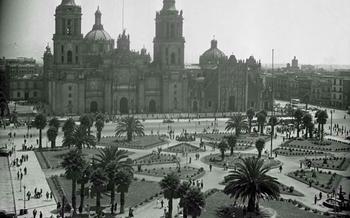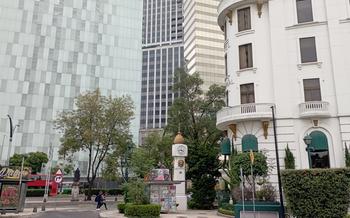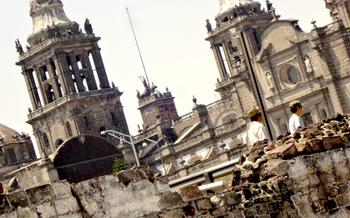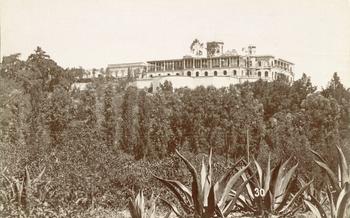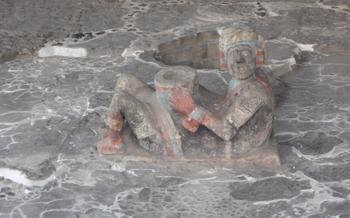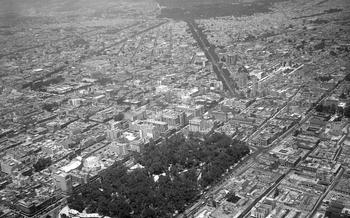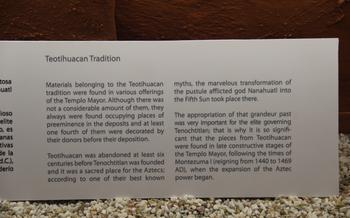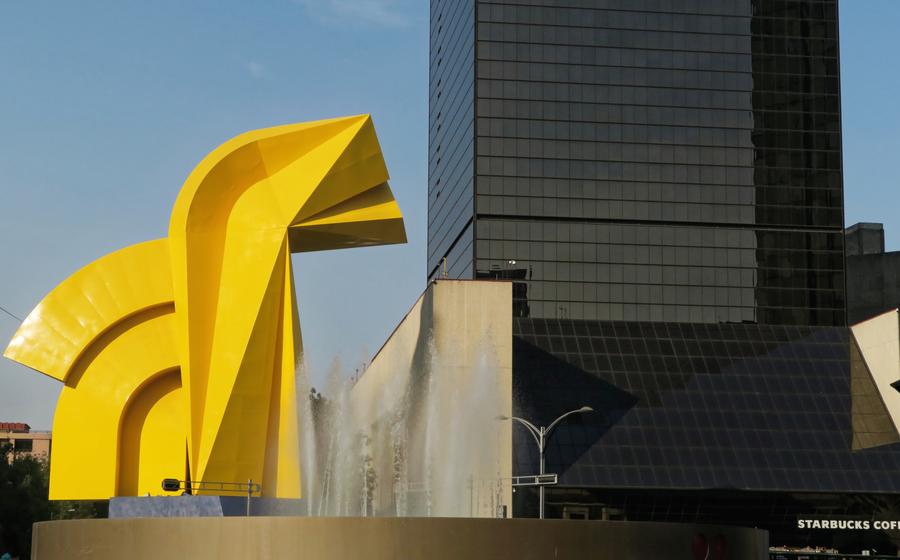
Paseo de la Reforma
- The Avenue of the Gods:
- The Monolith of Tlaloc: A Symbol of Aztec Reverence forlaloc stands as a testament to Aztec mythology and their profound reverence for water. This colossal sculpture, carved from a single block of basalt, stands at an impressive 5 meters tall and weighs approximately 5 tons. Its creation is shrouded in mystery, but it is believed to date back to the reign of Emperor Ahuizotl in the late 15th century.
- The Fuente de la Diana Cazadora: A Symbol of Resilience and Urban Icon
- The Museo Nacional de Antropología
- The Museo de Arte Moderno
- The Torre Latinoamericana: A Symbol of Modernity and Resilience
- Insider Tips for the Best Views:
- The Casa de los Azulejos: A Blue-Tiled Masterpiece
- The Mercado de San Juan
- Insider Tips
The Avenue of the Gods:
Paseo de la Reforma, stretching from Chapultepec Park to the Zócalo, is a grand boulevard in Mexico City, often referred to as the "Avenue of the Gods" due to its rich historical significance and abundance of iconic landmarks. Once a causeway connecting the city to the sacred site of Tenochtitlan, it now stands as a testament to Mexico's ancient past and vibrant present.
As you stroll along this tree-lined avenue, marvel at the architectural wonders that line its path. Admire the majestic Palacio de Bellas Artes, renowned for its stunning Art Nouveau architecture and world-class performances. Gaze upon the Monumento a la Revolución, a colossal monument honoring the heroes of the Mexican Revolution, its triumphal arch and observation deck offering breathtaking city views.
Immerse yourself in the cultural experiences and events that bring the Paseo de la Reforma to life. Witness the vibrant parades and celebrations that fill the streets during national holidays, or join the throngs of locals and tourists alike for the annual Day of the Dead procession, a spectacle of color, music, and remembrance.
Planning your visit to the Paseo de la Reforma is a breeze. Hop on the efficient metro system or hail a taxi to reach this central artery. Once you're there, take your time to explore its many attractions, indulging in the vibrant energy and rich history that make this avenue a must-see destination in Mexico City.
The Monolith of Tlaloc: A Symbol of Aztec Reverence forlaloc stands as a testament to Aztec mythology and their profound reverence for water. This colossal sculpture, carved from a single block of basalt, stands at an impressive 5 meters tall and weighs approximately 5 tons. Its creation is shrouded in mystery, but it is believed to date back to the reign of Emperor Ahuizotl in the late 15th century.
The monolith portrays Tlaloc, the Aztec god of rain, with his characteristic goggle eyes, prominent fangs, and headdress adorned with aquatic symbols. His open mouth, from which water once flowed, symbolizes his ability to control rainfall and bring life-giving moisture to the parched lands. This impressive sculpture serves as a poignant reminder of the Aztecs' dependence on agriculture and their deep gratitude for the life-sustaining rain.
Beyond its captivating physical presence, the Monolith of Tlaloc holds immense cultural significance. In Aztec mythology, Tlaloc was revered as the guardian of the mountains and the rain clouds. He was believed to reside in Tlalocan, a paradise-like realm where deceased children and those who had drowned were said to dwell. By placing this monolith within the Paseo de la Reforma, the Aztecs sought to honor their rain deity and ensure a steady flow of water for their crops and their people.
The Fuente de la Diana Cazadora: A Symbol of Resilience and Urban Icon
Amidst the bustling Paseo de la Reforma, the Fuente de la Diana Cazadora stands as a symbol of resilience and urban identity. Unveiled in 1942, this iconic fountain pays homage to the Roman goddess Diana, embodying strength, agility, and the untamed spirit of the hunt.
Crafted by the renowned Mexican sculptor Juan Fernando Olaguíbel, the fountain showcases Diana poised atop a majestic fountain, her lithe form capturing the essence of grace and power. Her piercing gaze and flowing hair evoke a sense of determination and freedom, while the water cascading around her symbolizes the life-giving force that sustains the city.
The fountain's prominent location, at the heart of the Paseo de la Reforma, further cements its significance as a cultural landmark. Surrounded by towering skyscrapers and vibrant city life, Diana stands as a beacon of hope and inspiration, a reminder of the enduring spirit of Mexico City.
Beyond its aesthetic beauty, the Fuente de la Diana Cazadora holds a special place in the hearts of Mexico City's residents. It has witnessed countless historical events, from political demonstrations to cultural celebrations, becoming an integral part of the city's identity.
Over the years, the fountain has become a gathering place, a backdrop for countless photographs, and a source of urban legends. Some believe that touching Diana's arrow will bring good luck, while others claim that her gaze can grant wishes.
The enduring appeal of the Fuente de la Diana Cazadora lies in its ability to capture the essence of Mexico City - a blend of history, mythology, and urban vitality. It is a symbol that represents the city's resilience, its cultural heritage, and its unwavering spirit.
The Museo Nacional de Antropología
A Treasure Trove of Ancient Mexican Civilizations
One of the world's most renowned anthropology museums, the Museo Nacional de Antropología, is a must-visit for anyone interested in Mexican history and culture. Located within Chapultepec Park, this architectural marvel houses an extensive collection of pre-Columbian artifacts, providing a comprehensive overview of Mexico's rich cultural heritage.
For over a century, the museum has preserved and showcased the legacy of ancient Mexican civilizations, including the Aztecs, Mayans, Olmecs, and Zapotecs. Its exhibits offer a captivating glimpse into their sophisticated art, religious beliefs, and daily lives. Highlights include the Sun Stone, a monumental Aztec calendar, and the colossal Olmec heads, enigmatic stone sculptures that symbolize power and divinity.
The museum's halls are a testament to the ingenuity and creativity of Mexico's indigenous peoples. The artifacts on display are not merely historical relics but tangible expressions of their cultural identity, showcasing their intricate weaving techniques, elaborate pottery designs, and awe-inspiring metalworking skills.
To fully appreciate the museum's vast collection, plan to spend at least half a day exploring its galleries. Allow yourself to be captivated by the stories behind each artifact, immersing yourself in the vibrant history of ancient Mexico. Guided tours are available in various languages, offering insights and context to enhance your visit.
Practical Information:
- Address: Av. Paseo de la Reforma y Calzada Gandhi S/N, Chapultepec Polanco, Miguel Hidalgo, 11560 Ciudad de México, CDMX
- Hours: Tuesday-Sunday, 10 am - 5 pm
- Admission: MXN $85 (approx. $4 USD)
- Website: mna.inah.gob.mx
- Tips:
- The museum is vast, so prioritize your interests and plan your route accordingly.
- Wear comfortable shoes as you'll be doing a lot of walking.
- Take advantage of the free guided tours (offered in Spanish and English) to delve deeper into the exhibits.
- The museum has a cafeteria and a gift shop where you can purchase souvenirs and books.
The Museo de Arte Moderno
A Haven for Modern and Contemporary Art Enthusiasts
Nestled within the vibrant cultural landscape of the Paseo de la Reforma, the Museo de Arte Moderno (MAM) stands as a testament to Mexico's rich artistic heritage and its embrace of the modern and contemporary art movements. This renowned institution houses an impressive collection that spans the globe, showcasing the works of both Mexican and international masters.
For art enthusiasts, a visit to MAM is an absolute must. Its rotating exhibitions offer a fresh perspective on the ever-evolving art scene, while the permanent collection features an array of masterpieces that will leave you in awe. From the vibrant colors of Mexican muralists to the abstract expressions of international icons, MAM's diverse collection provides a comprehensive journey through the history of modern art.
The museum's architectural design is equally captivating, blending modern elements with traditional Mexican touches to create a unique and inviting space. Wander through the spacious galleries, admiring the interplay of light and shadow as you immerse yourself in the world of modern art.
To make the most of your visit, consider joining a guided tour to gain insights into the stories behind the artworks and the artists who created them. Alternatively, take your time exploring the exhibits at your own pace, allowing yourself to be captivated by the visual feast before you.
Tips for Planning Your Visit:
-
Plan Your Visit: Before you go, check the museum's website for upcoming exhibitions and events to tailor your visit to your interests.
-
Guided Tours: Guided tours are available in Spanish and English, providing an in-depth understanding of the artwork and its historical context.
-
Explore the Museum's Collection Online: Get a sneak peek of the museum's collection by browsing their online database, which features thousands of artworks from all over the world.
-
Take Breaks: The museum is vast, so take breaks to rest and soak in the ambiance of the outdoor sculpture garden or enjoy a delicious meal at the on-site restaurant.
The Torre Latinoamericana: A Symbol of Modernity and Resilience
Rising majestically above the Paseo de la Reforma, the Torre Latinoamericana stands as an enduring symbol of Mexico City's architectural prowess and resilience. Completed in 1956, this 44-story skyscraper was once the tallest building in Latin America, a testament to the city's rapid modernization in the mid-20th century.
Designed by architects Augusto H. Álvarez and Pedro Ramírez Vázquez, the Torre Latinoamericana is a masterpiece of functionalist architecture. Its sleek, streamlined exterior and geometric forms reflect the prevailing international style of the era. The building's steel frame, a daring feat of engineering for its time, allowed for the creation of large, open spaces within, maximizing natural light and ventilation.
The Torre Latinoamericana has withstood several major earthquakes, including the devastating 1985 quake that caused widespread damage to the city. The building's sturdy construction and innovative seismic design elements, including a system of shock absorbers, ensured its survival, turning it into a symbol of resilience and engineering excellence.
Today, the Torre Latinoamericana is more than just an office building. It has become a beloved landmark and a popular tourist destination. Visitors can ascend to the observation deck on the 44th floor, which offers breathtaking panoramic views of Mexico City, stretching from the historic center to the sprawling metropolis beyond. The deck also features interactive exhibits that provide insights into the building's history, construction, and cultural significance.
Insider Tips for the Best Views:
- Arrive early to avoid crowds and secure a spot by the windows for unobstructed views.
- Don't forget your camera to capture the stunning cityscape and iconic landmarks.
- Check the weather forecast before your visit to ensure clear skies for optimal visibility.
- If you're visiting during the evening, stay until sunset to witness the city transform into a sea of twinkling lights.
- Combine your visit with a meal at the Torre Latinoamericana's restaurant, which offers delicious food and panoramic views.
The Casa de los Azulejos: A Blue-Tiled Masterpiece
Amidst the bustling streets of Mexico City's historic center, a remarkable architectural gem captures the attention of passersby - the Casa de los Azulejos, or House of Tiles. This stunning building, adorned with intricate blue-and-white tiles, stands as a testament to the city's rich cultural heritage and colonial past.
Constructed in the 16th century, the Casa de los Azulejos initially served as the residence of the Count of Orizaba, a wealthy Spanish nobleman. Over the years, it has undergone various transformations, serving as a palace, a government building, and even a luxury hotel. Today, it is a beloved cultural center and restaurant, welcoming visitors who come to admire its architectural grandeur and savor the flavors of traditional Mexican cuisine.
The building's most striking feature is undoubtedly its facade, covered in over 20,000 hand-painted talavera tiles. Each tile is meticulously crafted and arranged in intricate patterns, creating a mesmerizing visual tapestry. The vibrant blue hues, reminiscent of the Caribbean Sea, contrast beautifully with the white walls, evoking a sense of elegance and sophistication.
Inside, the Casa de los Azulejos boasts equally impressive interiors. The grand courtyard features a stunning fountain surrounded by lush greenery, providing a tranquil oasis amidst the city's hustle and bustle. The walls are adorned with murals and paintings depicting scenes from Mexican history and culture, adding to the building's artistic allure.
For those seeking a culinary adventure, the Casa de los Azulejos is home to a renowned restaurant serving authentic Mexican dishes prepared with fresh, local ingredients. Diners can savor traditional delicacies such as enchiladas, tacos, and mole poblano while immersing themselves in the building's historic ambiance.
To fully appreciate the beauty of the Casa de los Azulejos, be sure to visit during the daytime when the sunlight illuminates the tiles, casting a warm glow over the entire facade. Take your time to explore the intricate details of the tiles and admire the craftsmanship that went into creating this architectural masterpiece.
Whether you're a history buff, an architecture enthusiast, or simply someone who appreciates beautiful things, the Casa de los Azulejos is a must-see destination in Mexico City. This iconic building, with its blue-tiled splendor, promises a unique and unforgettable experience.
The Mercado de San Juan
A Culinary and Cultural Adventure:
Immerse yourself in the vibrant atmosphere of the Mercado de San Juan, a bustling traditional Mexican market that delights the senses with its diverse offerings. From aromatic spices and colorful handicrafts to an array of food stalls serving mouthwatering delicacies, this market is a culinary and cultural treasure.
Explore the labyrinthine alleys and discover hidden gems among the countless stalls. Sample exotic fruits, freshly baked pastries, and traditional Mexican dishes that burst with flavor. Indulge in the rich aromas of spices, herbs, and freshly ground coffee as you navigate the vibrant aisles.
Engage with the friendly locals, who are always willing to share their knowledge about the market's history, traditions, and culinary secrets. Learn about the significance of different ingredients and dishes, and don't miss the opportunity to savor some of the best street food that Mexico City has to offer.
For those seeking a truly authentic Mexican experience, the Mercado de San Juan is a must-visit destination. Remember to bring your appetite, an open mind, and a willingness to embrace the vibrant culture that surrounds you.
Insider Tip:
- Arrive early in the morning to beat the crowds and experience the market at its most vibrant.
- Don't be afraid to haggle with the vendors; it's part of the market culture.
- Be prepared to pay in cash, as many vendors may not accept credit cards.
- Take your time to explore the market and soak in the atmosphere; there's always something new to discover.
Insider Tips
Best Time to Visit
To fully appreciate the beauty and vibrancy of the Paseo de la Reforma, plan your visit during the spring (March-May) or fall (September-November) when the weather is pleasant and the crowds are smaller. Avoid the rainy season (June-August) if you want to enjoy outdoor activities without getting drenched.
Recommended Tours and Guides
Enhance your experience with a guided tour that provides historical insights and anecdotes about the Paseo de la Reforma's landmarks. Several reputable tour companies offer walking, cycling, or even Segway tours, allowing you to cover more ground and learn from local experts.
Hidden Gems and Lesser-Known Attractions
Venture beyond the main attractions to discover hidden gems along the Paseo de la Reforma. Look for the Monumento a Cuauhtémoc, a majestic statue honoring the last Aztec emperor, or the Museo de Cera, a wax museum showcasing life-like replicas of famous figures.
Safety Tips and Cultural Etiquette
Like any major city, Mexico City has its share of safety concerns. Be aware of your surroundings, avoid walking alone at night, and keep your valuables secure. Respect local customs and traditions, such as greeting people with a handshake or a kiss on the cheek, and refrain from taking photos of people without their permission.
By following these insider tips, you can make the most of your visit to the Paseo de la Reforma, immersing yourself in its rich history, vibrant culture, and iconic landmarks.
